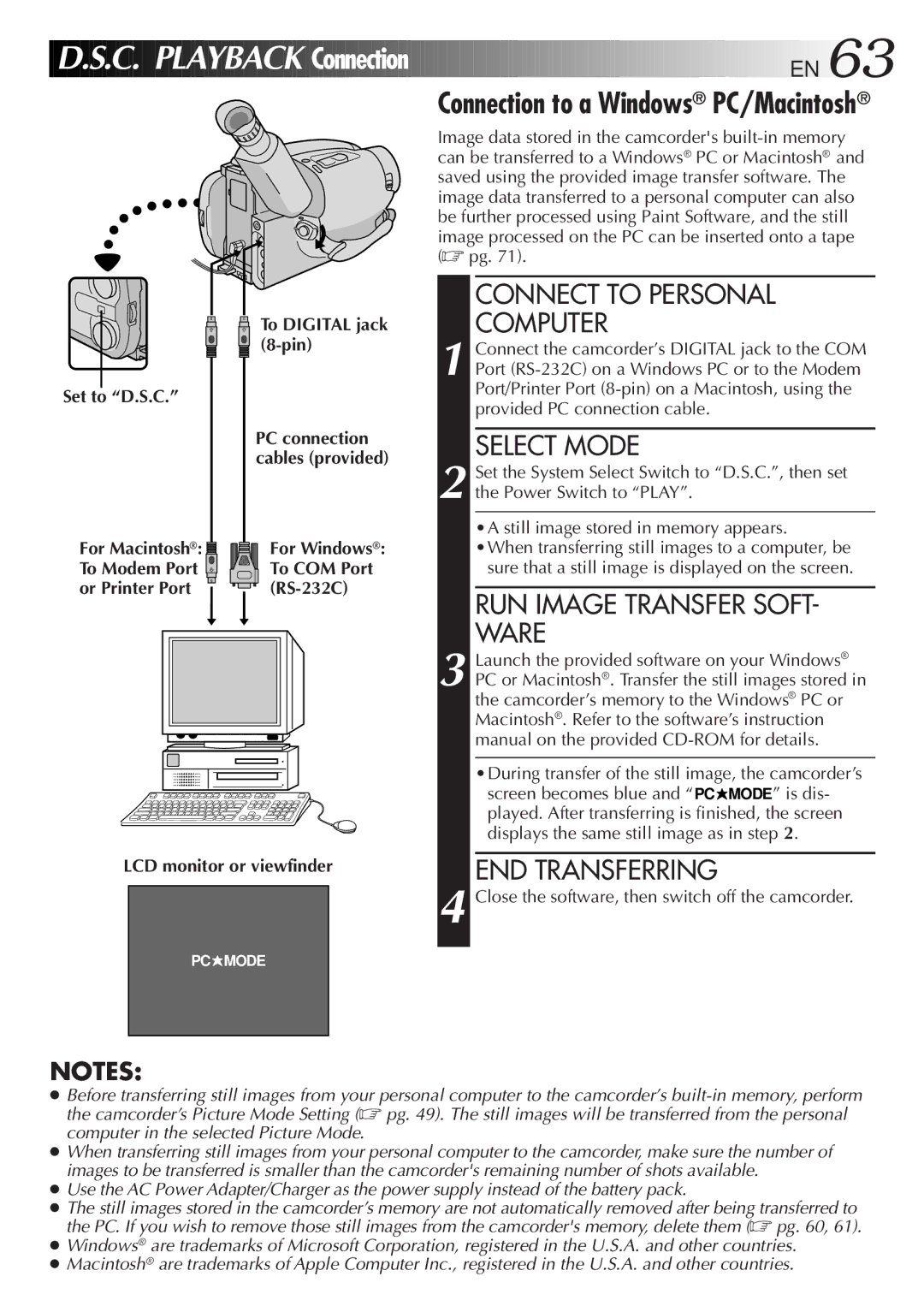For Customer Use
GR-AXM900
It is recommended that you
Dear Customer
Antenna Installation Instructions
Installation
Servicing
USE
Cassettes marked can be used with this camcorder
Major Features
Zoom-in
Zoom-out
Push Eject
Using the battery pack
To remove the battery pack
BATT. Release
Quick Operation Guide D.S.C. EN
Contents
Software programs
AC Power Adapter Cassette Adapter
Charger AA-V15U
BN-V11U
Detach Battery Pack
Power
Supply Power
Attach Battery Pack
Charge marker
To AC outlet DC OUT terminal To DC Jack AC Power
Car Battery Cord Lighter socket
Car Battery Charger/Adapter
Close the compartment cover until it clicks in place
Insert Battery
Getting Started
Close Cover
Select Dial
Menu
Jog Dial LCD monitor or viewfinder
Viewfinder Adjustment
Grip Adjustment
Attach Strap
Adjust Length
Shoulder Strap Attachment
Tripod Mounting
Tape Length Setting
Recording Mode Setting
Loading/Unloading a Cassette
Start Shooting
Enter RECORD-STANDBY Mode
Basic Recording
Load a Cassette
Blinking
Tape remaining time indicator
Stop Recording
Now calculating
Lights while recording Switch Is in progress
Power Switch Start/Stop Button
Journalistic shooting
Interface shooting
Brightness control
Menu Screen
Basic Features
Zoom Speed Setting Menu Zooming Speed 1 4 in order of speed
When the Select Dial is set to Auto Lock
Feature
Purpose
Operation
Display Select Dial
Video Recording Basic Features
Feature Purpose Operation
DATE/TIME
Video Light
To brighten the scene when natural lighting is too dim
Set the Light OFF/AUTO/ON Switch as required
Mode when you use the video light
Take Snapshot
Video Recording Basic Features
Select Snapshot Mode
Snapshot
Pictrue mode display Fine or STD standard Pin-Up
LCD monitor or viewfinder Fine 12Remaining number of shots
Full
LCD monitor or viewfinder Mark
EN Video Recording Advanced Features
Second later, the mode is activated After 1 sec
Program AE With Special Effects
ND Effect
Auto Mode Lock
Auto Mode Release
Electronic Fog Filter
Fade/Wipe
Advanced Features
Engage FADE- or Wipe Standby Mode
To Cancel FADE- or WIPE- Standby Mode
Super LoLuxGain Up
Engage Wide Mode
Select Super Lolux Mode
Wide
Title
Select Preset Title
Instant Titles
LCD monitor or viewfinder Title display
Setting Menu Ex. Title Lang
Using Menu For Detailed Adjustment
Make Setting
END Setting
EN Video Recording
Etc. When Demo Mode is set to on and the Menu Screen
Tally lamp comes on to signal the start of recording
Functions are disabled
Setting is
Patterns that are regularly repeated
Focusing
END Adjustment of Focus
Focus Menu Screen
Manual Focus Screen
To darken the image
Manual Exposure Screen To brighten the image
Manual White Balance Adjustment M.W.B
INT. Time
Indicator
INT. Time Menu
REC Time Menu
SET Recording Time
Release Animation Mode
Time-Lapse
SET Interval Between Recordings
REW
Basic Playback
Rewind or Fast-forward the tape
Play Back
Tracking
Features EN
Speaker volume control
Adjust Volume
Counter R/M REW
Video Playback Features
Play Back on Connected VCR
Using The Cassette Adapter EN
Cassette Adapter VHS Playpak
Insert Cassette in Adapter
Turn on the camcorder, the VCR and the TV
When connecting the cables, open the jack cover
Connect Camcorder to VCR
Connect Camcorder to TV
To Audio Video OUT connectors Video in connectors
VCR Recording deck
PLAY/PAUSE
Shoot
Select Picture Mode
Mode Snapshot
Basic Shooting
Select Function
Picture Mode Setting Menu
Picture Mode Setting
SET Picture Mode
Mode Function
C. Shooting Advanced Features
Colors of a picture are reversed pg
Focusing pg
Captures faster action than Sports mode pg
High shutter speed clearly captures fast-moving action pg
If you select FOCUS, Exposure or DATE/ Time
On Next
Mode when you wish to shoot many still images
Is better than STANDARD, Fine is more suitable for post
Production on a PC
Disabled
Setting is impossible
Titles etc. When Demo Mode is set to on and the Menu
By turning off the camcorder, Demo Mode is set to OFF
Basic Playback EN
C. Playback
Normal Screen
C. Playback Advanced Features
ALL
Mode Effect
Images you shot beforehand pg
Select
Access Index Menu Screen
Index
View Index Images
SET Protect
Protect
Screen
Access Delete Menu Screen
Select Delete Mode
Delete
Case of Select
Access Delete Execute Menu Screen
Menu Screen Ex. Slide Show
Slide Show
END Transferring
C. Playback Connection
Connect to Personal Computer
RUN Image Transfer SOFT- Ware
Functions
Pull OUT Battery Holder
Replace Battery Holder
RM-V705URM-V700U Providedoptional
Interval Timer Indicator
Rec Time Indicator
Transmitted beam effective area
Operate VCR
Using Remote Control Unit
Random Assemble Editing R.A.Edit
SET Remote to Operate VCR
Recording deck
Connect to
Prepare Camcorder
Prepare VCR
Cont
ON/OFF VCR REC Stby
Engage VCR’S RECORD-PAUSE Mode
Begin Automatic Editing
END Automatic Editing
LCD monitor or viewfinder System Select Switch
START/STOP REW Play Pause Insert
RM-V700URM-V705U Optional or provided
END Insert Editing
Button Power Switch
Select Still Image
Begin Insert Editing
REW Play Pause DUB
Audio dubbing indicator
Remove Marks
Open/Close Switch Set to Power OFF
Lens Cover
BATT. Release Push Eject
74EN
@ Picture Stabilizer Indicator
Recording Mode SP/EP
Displayed when any of the buttons located
Tape Length Indicator
76EN
Picture Stabilizer Button REW Button
Diopter Adjustment
Select Dial
DATE/TIME Button
Delete Select Menu Screen
Charging the Battery Pack
Discharge The Battery Pack High Speed Shutter Mode
Fast-Forward Tape
Pg , 51
Random Assemble Editing
Recording, Start/Stop Video
Remove Cassette
Some functions are not available
No power is supplied
Recording cannot be performed Recording does not start
Playback
Format Menu Screen
Troubleshooting
Plug adapter
To prevent damage and prolong service life
Using Household AC Plug Adapter
To avoid hazard
Store cassettes
For safety, do not
Avoid using the unit
During use
Serious malfunctioning
To prolong service life
To prevent damage to the LCD monitor, do not
About moisture condensation
Specifications
Colocacion DE LA Bateria
Español
Alimentación
Alimentacion
Abra
Utilización de la batería
Para extraer la batería
Enganche Empuje
3Botón página
Guia Para Operacion Rapida D.S.C. EN
Enganche 4Botón Snapshot 2Empuje Perilla de
Colóquelo en Camera
EN for Servicing Only in U.S.A
HOW to Locate Your JVC Service Center
Limited Warranty
Warranty Only in U.S.A. EN
GR-AXM900

